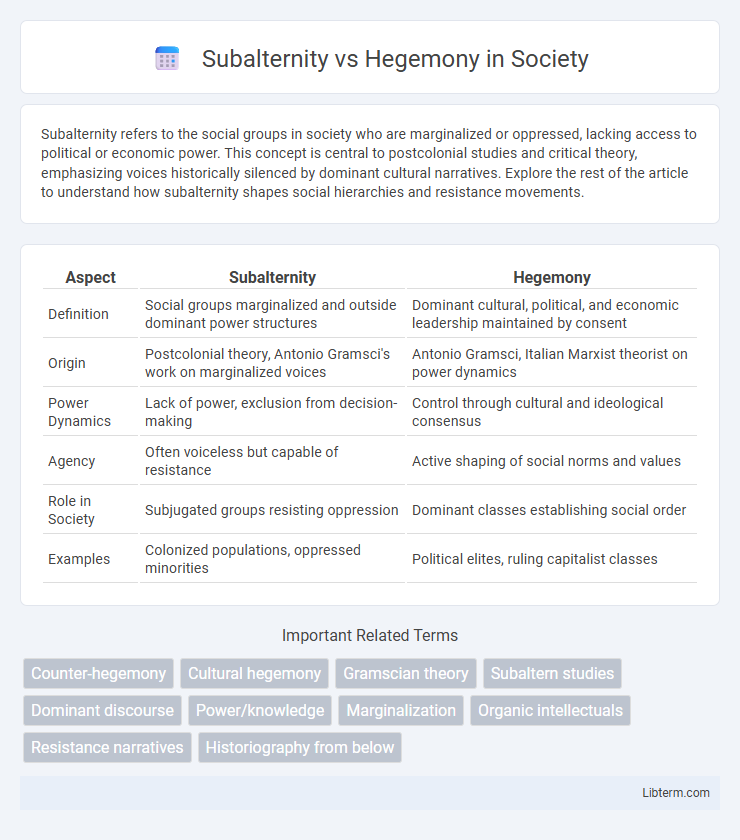Subalternity refers to the social groups in society who are marginalized or oppressed, lacking access to political or economic power. This concept is central to postcolonial studies and critical theory, emphasizing voices historically silenced by dominant cultural narratives. Explore the rest of the article to understand how subalternity shapes social hierarchies and resistance movements.
Table of Comparison
| Aspect | Subalternity | Hegemony |
|---|---|---|
| Definition | Social groups marginalized and outside dominant power structures | Dominant cultural, political, and economic leadership maintained by consent |
| Origin | Postcolonial theory, Antonio Gramsci's work on marginalized voices | Antonio Gramsci, Italian Marxist theorist on power dynamics |
| Power Dynamics | Lack of power, exclusion from decision-making | Control through cultural and ideological consensus |
| Agency | Often voiceless but capable of resistance | Active shaping of social norms and values |
| Role in Society | Subjugated groups resisting oppression | Dominant classes establishing social order |
| Examples | Colonized populations, oppressed minorities | Political elites, ruling capitalist classes |
Understanding Subalternity: Definition and Origins
Subalternity refers to the social groups excluded from the hegemonic power structures and dominant discourse, primarily studied within postcolonial theory and critical social theory. Coined by scholars like Antonio Gramsci and later expanded by Gayatri Chakravorty Spivak, subalternity highlights the marginalization of oppressed populations who lack access to institutionalized forms of representation. Understanding subalternity requires examining the ways in which power relations silence these groups, contrasting with hegemony, which denotes the dominant cultural and political leadership maintained through consent and coercion.
Defining Hegemony: Power and Influence
Hegemony refers to the dominant power exerted by a ruling group over others through cultural, ideological, and political means, shaping societal norms and values. It extends beyond direct control, embedding influence within institutions and everyday practices to maintain authority. This concept underscores how power operates subtly via consensual social structures rather than overt coercion.
Historical Contexts: Subalterns and Hegemonic Forces
Subalternity refers to marginalized groups excluded from dominant power structures, often emerging in colonial and postcolonial historical contexts where indigenous populations and lower classes faced systemic oppression. Hegemony, as theorized by Antonio Gramsci, involves the cultural and ideological dominance exerted by ruling classes to maintain control over society. Historical struggles between subaltern groups and hegemonic forces reveal ongoing conflicts over identity, power, and resistance within colonial empires and modern nation-states.
Theoretical Frameworks: Gramsci and Beyond
Gramsci's theoretical framework of hegemony explores how dominant groups maintain power through cultural and ideological consent rather than coercion, emphasizing the role of intellectuals in shaping societal norms. Subalternity, as developed by scholars like Spivak and Guha, critiques this by highlighting the marginalization and silencing of subordinated groups whose voices are excluded from hegemonic discourse. Postcolonial theory extends Gramsci's concepts by analyzing the power dynamics between colonizers and the colonized, revealing the limitations of hegemony in addressing the lived experiences of subaltern subjects.
Subaltern Voices: Representation and Silencing
Subaltern voices often face systemic silencing within hegemonic power structures that prioritize dominant narratives. Representation of subaltern groups requires dismantling entrenched socio-political hierarchies to enable authentic articulation of marginalized experiences. Critical discourse on subalternity underscores the necessity of amplifying these suppressed voices to challenge hegemonic cultural and ideological control.
Mechanisms of Hegemonic Control
Mechanisms of hegemonic control operate through cultural institutions, media, and education systems that propagate dominant ideologies, shaping public consciousness to maintain power structures. Subaltern groups are often marginalized by these mechanisms, as their voices and experiences are suppressed or co-opted to reinforce hegemony. This dynamic creates a social framework where consent is manufactured, limiting resistance and sustaining the status quo.
Resistance and Agency: Subaltern Strategies
Subaltern groups employ resistance and agency to challenge hegemonic power structures through strategic actions such as grassroots mobilization, subversive narratives, and cultural reclamation. These subaltern strategies create alternative spaces of empowerment that undermine dominant discourses and reshape social hierarchies. By asserting collective voice and identity, subaltern actors negotiate power dynamics and disrupt hegemonic dominance.
Cultural Hegemony and Media Influence
Cultural hegemony, a concept developed by Antonio Gramsci, describes how dominant groups maintain power by shaping societal norms and values through media and cultural institutions, embedding their worldview as the cultural norm. Media influence plays a crucial role in perpetuating this hegemony by selectively framing information, reinforcing dominant ideologies, and marginalizing subaltern voices, thereby limiting alternative perspectives. The struggle between subalternity and hegemony involves the resistance of oppressed groups attempting to challenge and disrupt these dominant cultural narratives imposed through media control.
Intersectionality: Class, Gender, and Race in Subalternity
Subalternity examines marginalized groups excluded from dominant power structures, intersecting class, gender, and race to reveal overlapping systems of oppression. Hegemony involves the dominant class's control over cultural and ideological norms, often obscuring the lived experiences of subaltern groups through ideological dominance. Intersectionality highlights how subaltern identities experience compounded discrimination, emphasizing the need to analyze power beyond single-axis frameworks like class or race alone.
Moving Forward: Challenging Hegemony and Empowering Subalterns
Challenging hegemony involves recognizing and dismantling dominant power structures that marginalize subaltern groups, ensuring their voices are central to social and political discourse. Empowering subalterns requires fostering inclusive platforms that validate diverse experiences and facilitate access to resources, education, and decision-making. Strategies like grassroots activism, decolonial education, and participatory governance enable a transformative shift towards equity and justice.
Subalternity Infographic

 libterm.com
libterm.com